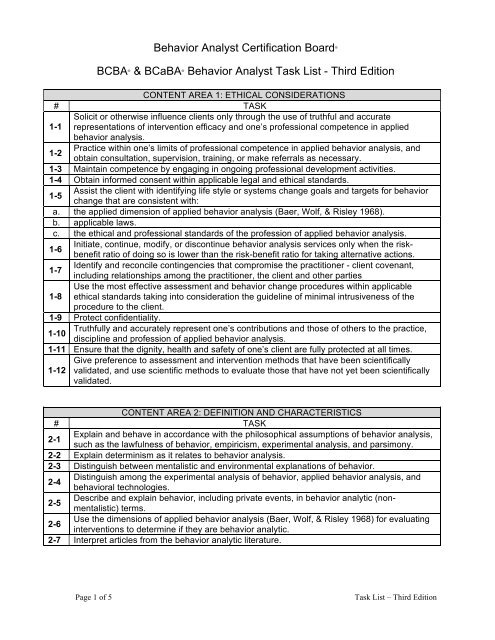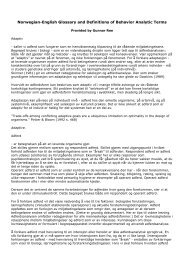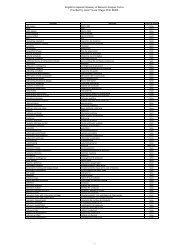Task List - Behavior Analyst Certification Board
Task List - Behavior Analyst Certification Board
Task List - Behavior Analyst Certification Board
Create successful ePaper yourself
Turn your PDF publications into a flip-book with our unique Google optimized e-Paper software.
<strong>Behavior</strong> <strong>Analyst</strong> <strong>Certification</strong> <strong>Board</strong> ®<br />
BCBA ® & BCaBA ® <strong>Behavior</strong> <strong>Analyst</strong> <strong>Task</strong> <strong>List</strong> - Third Edition<br />
CONTENT AREA 1: ETHICAL CONSIDERATIONS<br />
# TASK<br />
Solicit or otherwise influence clients only through the use of truthful and accurate<br />
1-1 representations of intervention efficacy and one’s professional competence in applied<br />
behavior analysis.<br />
Practice within one’s limits of professional competence in applied behavior analysis, and<br />
1-2<br />
obtain consultation, supervision, training, or make referrals as necessary.<br />
1-3 Maintain competence by engaging in ongoing professional development activities.<br />
1-4 Obtain informed consent within applicable legal and ethical standards.<br />
Assist the client with identifying life style or systems change goals and targets for behavior<br />
1-5<br />
change that are consistent with:<br />
a. the applied dimension of applied behavior analysis (Baer, Wolf, & Risley 1968).<br />
b. applicable laws.<br />
c. the ethical and professional standards of the profession of applied behavior analysis.<br />
Initiate, continue, modify, or discontinue behavior analysis services only when the risk-<br />
1-6<br />
benefit ratio of doing so is lower than the risk-benefit ratio for taking alternative actions.<br />
Identify and reconcile contingencies that compromise the practitioner - client covenant,<br />
1-7<br />
including relationships among the practitioner, the client and other parties<br />
Use the most effective assessment and behavior change procedures within applicable<br />
1-8 ethical standards taking into consideration the guideline of minimal intrusiveness of the<br />
procedure to the client.<br />
1-9 Protect confidentiality.<br />
Truthfully and accurately represent one’s contributions and those of others to the practice,<br />
1-10<br />
discipline and profession of applied behavior analysis.<br />
1-11 Ensure that the dignity, health and safety of one’s client are fully protected at all times.<br />
Give preference to assessment and intervention methods that have been scientifically<br />
1-12 validated, and use scientific methods to evaluate those that have not yet been scientifically<br />
validated.<br />
#<br />
CONTENT AREA 2: DEFINITION AND CHARACTERISTICS<br />
TASK<br />
2-1<br />
Explain and behave in accordance with the philosophical assumptions of behavior analysis,<br />
2<br />
such as the lawfulness of behavior, empiricism, experimental analysis, and parsimony.<br />
2-2 Explain determinism as it relates to behavior analysis.<br />
2-3 Distinguish 2 between mentalistic and environmental explanations of behavior.<br />
2-4<br />
Distinguish among the experimental analysis of behavior, applied behavior analysis, and<br />
behavioral technologies.<br />
2-5<br />
Describe and explain behavior, including private events, in behavior analytic (nonmentalistic)<br />
terms.<br />
2-6<br />
Use the dimensions of applied behavior analysis (Baer, Wolf, & Risley 1968) for evaluating<br />
2<br />
interventions to determine if they are behavior analytic.<br />
2-7 Interpret 2 articles from the behavior analytic literature.<br />
Page 1 of 5 <strong>Task</strong> <strong>List</strong> – Third Edition
CONTENT AREA 3: PRINCIPLES, PROCESSES AND CONCEPTS<br />
# TASK<br />
3-1 Define and provide examples of behavior/response/response class.<br />
3-2 Define and provide examples of stimulus and stimulus class.<br />
3-3 Define and provide examples of positive and negative reinforcement.<br />
3-4 Define and provide examples of conditioned and unconditioned reinforcement.<br />
3-5 Define and provide examples of positive and negative punishment.<br />
3-6 Define and provide examples of conditioned and unconditioned punishment.<br />
3-7 Define and provide examples of stimulus control.<br />
3-8 Define and provide examples of establishing operations.<br />
3-9 Define and provide examples of behavioral contingencies.<br />
3-10 Define and provide examples of functional relations.<br />
3-11 Define and provide examples of extinction.<br />
3-12 Define and provide examples of generalization and discrimination.<br />
3-13 Describe and provide examples of the respondent conditioning paradigm.<br />
3-14 Describe and provide examples of the operant conditioning paradigm.<br />
3-15 Define and provide examples of echoics and imitation.<br />
3-16 Define and provide examples of mands.<br />
3-17 Define and provide examples of tacts.<br />
3-18 Define and provide examples of intraverbals.<br />
3-19<br />
Define and provide examples of contingency-shaped and rule governed behavior and<br />
distinguish between examples of each.<br />
CONTENT AREA 4: BEHAVIORAL ASSESSMENT<br />
# TASK<br />
4-1 State the primary characteristics of and rationale for conducting a descriptive assessment.<br />
4-2 Gather descriptive data.<br />
a. Select various methods.<br />
b. Use various methods.<br />
4-3 Organize and interpret descriptive data.<br />
a. Select various methods.<br />
b. Use various methods.<br />
4-4<br />
State the primary characteristics of and rationale for conducting a functional analysis as a<br />
form of assessment.<br />
4-5 Conduct functional analyses.<br />
a. Select various methods.<br />
b. Use various methods.<br />
4-6 Organize and interpret functional analysis data.<br />
a. Select various methods.<br />
b. Use various methods.<br />
Page 2 of 5 <strong>Task</strong> <strong>List</strong> – Third Edition
CONTENT AREA 5: EXPERIMENTAL EVALUATION OF INTERVENTIONS<br />
# TASK<br />
5-1 Systematically manipulate independent variables to analyze their effects on treatment.<br />
a. Use withdrawal designs.<br />
b. Use reversal designs.<br />
c.<br />
Use alternating treatments (i.e., multi-element, simultaneous treatment, multiple or<br />
concurrent schedule) designs.<br />
d. Use changing criterion design.<br />
e. Use multiple baseline designs.<br />
5-2<br />
Identify and address practical and ethical considerations in using various experimental<br />
designs.<br />
5-3<br />
Conduct a component analysis (i.e., determining effective component(s) of an intervention<br />
5-4<br />
package).<br />
Conduct a parametric analysis (i.e., determining effective parametric values of<br />
consequences, such as duration or magnitude).<br />
#<br />
CONTENT AREA 6: MEASUREMENT OF BEHAVIOR<br />
TASK<br />
6-1<br />
Identify the measurable dimensions of behavior (e.g., rate, duration, latency, or interresponse<br />
times).<br />
6-2 Define behavior in observable and measurable terms.<br />
State the advantages and disadvantages of using continuous measurement procedures<br />
6-3 and sampling techniques (e.g., partial- and whole-interval recording, momentary time<br />
sampling).<br />
6-4<br />
Select the appropriate measurement procedure given the dimensions of the behavior and<br />
the logistics of observing and recording.<br />
6-5 Select a schedule of observation and recording periods.<br />
6-6 Use frequency (i.e., count).<br />
6-7 Use rate (i.e., count per unit time).<br />
6-8 Use duration.<br />
6-9 Use latency.<br />
6-10 Use inter-response time (IRT).<br />
6-11 Use percent of occurrence.<br />
6-12 Use trials to criterion.<br />
6-13 Use interval recording methods.<br />
6-14<br />
Use various methods of evaluating the outcomes of measurement procedures, such as<br />
inter-observer agreement, accuracy, and reliability.<br />
CONTENT AREA 7: DISPLAYING AND INTERPRETING BEHAVIORAL DATA<br />
# TASK<br />
7-1 Select a data display that effectively communicates quantitative relations.<br />
7-2 Use equal-interval graphs.<br />
7-3 Use Standard Celeration Charts (for BCBA only – excluded for BCaBA).<br />
7-4 Use a cumulative record to display data.<br />
7-5 Use data displays that highlight patterns of behavior (e.g., scatter plot).<br />
7-6 Interpret and base decision-making on data displayed in various formats.<br />
Page 3 of 5 <strong>Task</strong> <strong>List</strong> – Third Edition
CONTENT AREA 8: SELECTING INTERVENTION OUTCOMES AND STRATEGIES<br />
# TASK<br />
8-1 Conduct a task analysis.<br />
8-2<br />
Make recommendations to the client regarding target outcomes based upon such<br />
factors as: client preferences, task analysis, current repertoires, supporting<br />
environments, constraints, social validity, assessment results and best available<br />
scientific evidence.<br />
8-3 State target intervention outcomes in observable and measurable terms.<br />
8-4<br />
8-5<br />
8-6<br />
8-7<br />
8-8<br />
Make recommendations to the client regarding intervention strategies based on such<br />
factors as: client preferences, task analysis, current repertoires, supporting<br />
environments, constraints, social validity, assessment results and best available<br />
scientific evidence.<br />
Make recommendations to the client regarding behaviors that must be established,<br />
strengthened, and/or weakened to attain the stated intervention outcomes.<br />
When a behavior is to be weakened, select an acceptable alternative behavior to be<br />
established or strengthened.<br />
Determine and make environmental changes that reduce the need for behavior<br />
analysis services.<br />
Identify the contingencies governing the behavior of those responsible for carrying out<br />
behavior change procedures and design interventions accordingly.<br />
#<br />
CONTENT AREA 9: BEHAVIOR CHANGE PROCEDURES<br />
TASK<br />
9-1<br />
Use antecedent-based interventions, such as: contextual or ecological variables,<br />
establishing operations, and discriminative stimuli.<br />
9-2 Use positive and negative reinforcement:<br />
a. Identify and use reinforcers.<br />
b. Use appropriate parameters and schedules of reinforcement.<br />
c. Use response-deprivation procedures (e.g., Premack principle).<br />
d. State and plan for the possible unwanted effects of the use of reinforcement.<br />
9-3 Use positive and negative punishment:<br />
a. Identify and use punishers.<br />
b. Use appropriate parameters and schedules of punishment.<br />
c. State and plan for the possible unwanted effects of the use of punishment.<br />
9-4 Use extinction.<br />
a. Identify possible reinforcers maintaining behavior and use extinction.<br />
b. State and plan for the possible unwanted effects of the use of extinction.<br />
9-5 Use response-independent (time-based) schedules of reinforcement.<br />
9-6 Use differential reinforcement.<br />
9-7 Use discrimination training procedures.<br />
9-8 Use prompt and prompt fading.<br />
9-9 Use instructions and rules.<br />
9-10 Use modeling and imitation.<br />
9-11 Use shaping.<br />
9-12 Use chaining.<br />
9-13 Use incidental teaching techniques.<br />
9-14 Use Direct Instruction.<br />
9-15 Use precision teaching.<br />
9-16 Use personalized system of instruction (PSI).<br />
9-17 Use discrete trials.<br />
Page 4 of 5 <strong>Task</strong> <strong>List</strong> – Third Edition
9-18 Use contingency contracting (e.g., behavioral contracts).<br />
9-19 Use token economy procedures, including levels systems.<br />
9-20 Use independent, interdependent and dependent group contingencies.<br />
9-21 Use stimulus equivalence procedures.<br />
9-22 Plan for behavioral contrast effects.<br />
9-23 Use behavioral momentum.<br />
9-24 Use the matching law and recognize factors influencing choice.<br />
9-25<br />
Use language acquisition programs that employ Skinner’s analysis of verbal behavior (i.e.,<br />
echoics, mands, tacts, intraverbals).<br />
9-26 Use language acquisition/communication training procedures.<br />
9-27 Use self-management strategies.<br />
9-28 Use behavior change procedures to promote stimulus and response generalization.<br />
9-29 Use behavior change procedures to promote maintenance.<br />
#<br />
CONTENT AREA 10: SYSTEMS SUPPORT<br />
TASK<br />
10-1<br />
Use competency-based training for persons who are responsible for carrying out<br />
behavioral assessment and behavior change procedures.<br />
10-2 Use effective performance monitoring and reinforcement systems.<br />
10-3 Design and use systems for monitoring procedural integrity.<br />
10-4<br />
Establish support for behavior analysis services from persons directly and indirectly<br />
involved with these services.<br />
10-5<br />
Secure the support of others to maintain the clients’ behavioral repertoires in their natural<br />
settings.<br />
10-6<br />
Provide behavior analysis services in collaboration with others who support and/or provide<br />
services to one’s clients.<br />
Copyright © 2002-2010 the <strong>Behavior</strong> <strong>Analyst</strong> <strong>Certification</strong> <strong>Board</strong>, Inc., ® (BACB®), ALL<br />
RIGHTS RESERVED. Unauthorized reproduction, copying or transmission in any<br />
medium is strictly prohibited. This Job <strong>Task</strong> <strong>List</strong> is made available to the public ONLY<br />
FOR USE BY CANDIDATES FOR BACB CERTIFICATION FOR RECERTIFICATION.<br />
Use for any other purpose is strictly prohibited.<br />
Page 5 of 5 <strong>Task</strong> <strong>List</strong> – Third Edition






